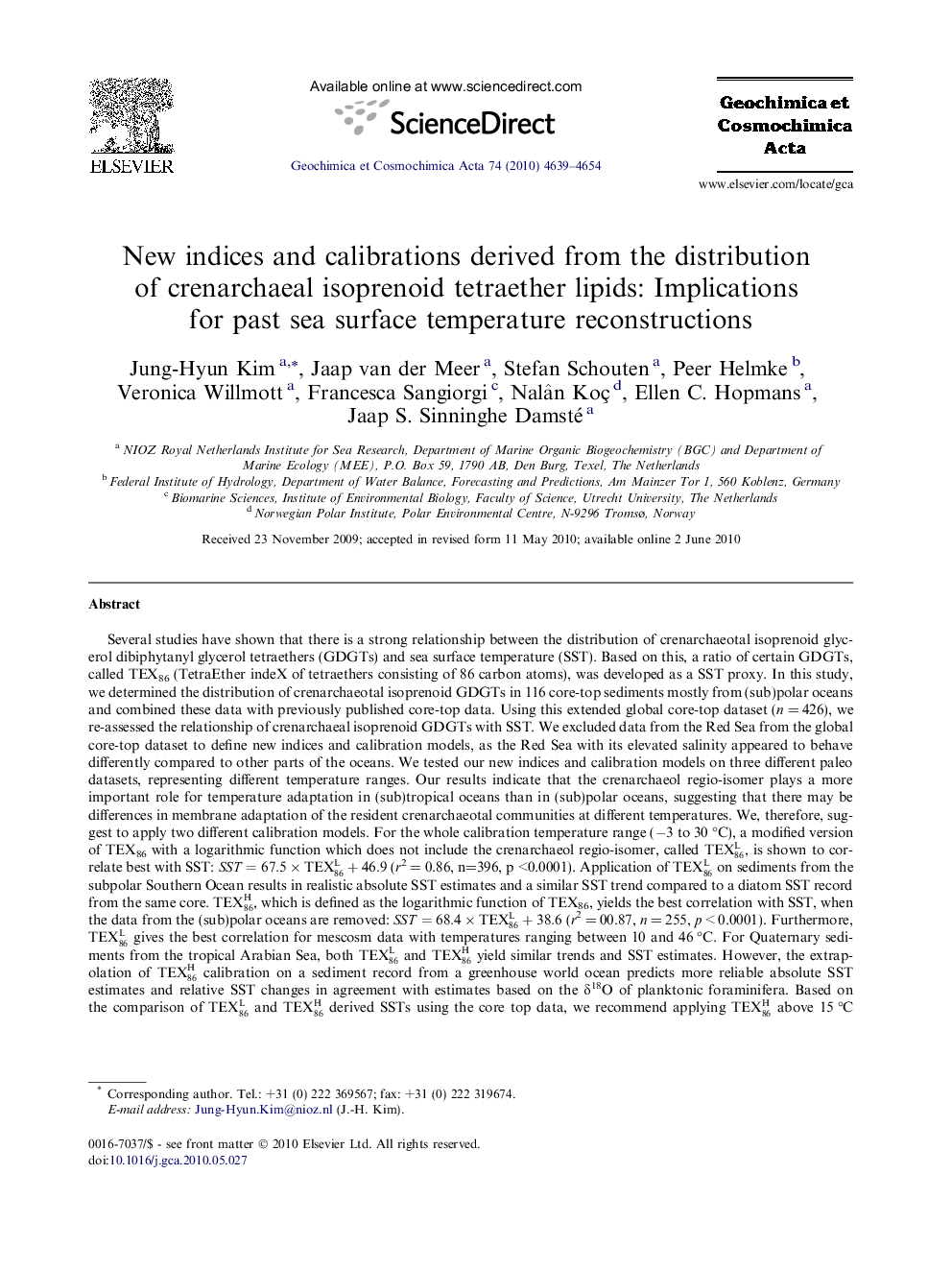| کد مقاله | کد نشریه | سال انتشار | مقاله انگلیسی | نسخه تمام متن |
|---|---|---|---|---|
| 4703886 | 1352885 | 2010 | 16 صفحه PDF | دانلود رایگان |

Several studies have shown that there is a strong relationship between the distribution of crenarchaeotal isoprenoid glycerol dibiphytanyl glycerol tetraethers (GDGTs) and sea surface temperature (SST). Based on this, a ratio of certain GDGTs, called TEX86 (TetraEther indeX of tetraethers consisting of 86 carbon atoms), was developed as a SST proxy. In this study, we determined the distribution of crenarchaeotal isoprenoid GDGTs in 116 core-top sediments mostly from (sub)polar oceans and combined these data with previously published core-top data. Using this extended global core-top dataset (n = 426), we re-assessed the relationship of crenarchaeal isoprenoid GDGTs with SST. We excluded data from the Red Sea from the global core-top dataset to define new indices and calibration models, as the Red Sea with its elevated salinity appeared to behave differently compared to other parts of the oceans. We tested our new indices and calibration models on three different paleo datasets, representing different temperature ranges. Our results indicate that the crenarchaeol regio-isomer plays a more important role for temperature adaptation in (sub)tropical oceans than in (sub)polar oceans, suggesting that there may be differences in membrane adaptation of the resident crenarchaeotal communities at different temperatures. We, therefore, suggest to apply two different calibration models. For the whole calibration temperature range (−3 to 30 °C), a modified version of TEX86 with a logarithmic function which does not include the crenarchaeol regio-isomer, called TEX86L, is shown to correlate best with SST: SST=67.5×TEX86L+46.9 (r2 = 0.86, n=396, p <0.0001). Application of TEX86L on sediments from the subpolar Southern Ocean results in realistic absolute SST estimates and a similar SST trend compared to a diatom SST record from the same core. TEX86H, which is defined as the logarithmic function of TEX86, yields the best correlation with SST, when the data from the (sub)polar oceans are removed: SST=68.4×TEX86L+38.6 (r2 = 00.87, n = 255, p < 0.0001). Furthermore, TEX86L gives the best correlation for mescosm data with temperatures ranging between 10 and 46 °C. For Quaternary sediments from the tropical Arabian Sea, both TEX86L and TEX86H yield similar trends and SST estimates. However, the extrapolation of TEX86H calibration on a sediment record from a greenhouse world ocean predicts more reliable absolute SST estimates and relative SST changes in agreement with estimates based on the δ18O of planktonic foraminifera. Based on the comparison of TEX86L and TEX86H derived SSTs using the core top data, we recommend applying TEX86H above 15 °C and TEX86L below 15 °C. In cases where paleorecords encompass temperatures both below and above 15 °C, we suggest to use TEX86L.
Journal: Geochimica et Cosmochimica Acta - Volume 74, Issue 16, 15 August 2010, Pages 4639–4654